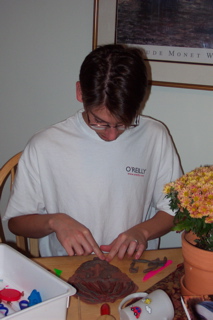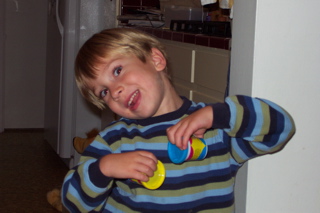May 16, 2007 at 11:21 pm
· Filed under Creativity
It’s a frightful thing, the power that music can have on my emotions. It’s a frightful thing, my emotions. When reason reigns, and feeling has no reason, then feeling only threatens. Feeling is responsible for the arbitrary associations I find in my neurology. A smell, a sound, a rush of memory. The object, for me, is forever tainted. And for what reason? Of course I do not want to subject myself to such randomness. I do not indulge. I love music. Therefore I do not listen to it. Indulgence is mindless. I have no control over the result. What new links are going to get created inside me that I had no say in allowing? Experience is a demon, always threatening to possess me. So I must stay on guard. Is it any wonder I don’t remember so much of my childhood? I did not allow it to possess me like a demon. I cut it short. Masterfully.
I must stay on guard, because it’s a powerful beast. Atrophied, yet still it heaves with terrible strength. If I’m careful, I can keep the noise loud enough to drown out its breathing. When it does come through–and I feel the disgusting feeling of nostalgia, the heart-breaking feeling of nostalgia–I’m vindicated in my resolve. If I can’t have the experience back, then why flirt with it? Do I enjoy pain? Shall I enjoy grief? And so I pretend that emotions are scarce. Feeling is a sacred, pure thing reserved for lofty notions. I’ve always known better than those who lose themselves at rock concerts.
Permalink
May 27, 2005 at 6:03 am
· Filed under Creativity

This morning’s reading is for my class. It’s from a book called Visual Intelligence: How We Create What We See. One of the things it talks about is how our brain constructs lines from the light that enters our eyes:
And that is what you do each time you see a line. You construct it from receptor responses. This is not so easy as you might think. Just ask researchers in computer vision. They have worked on “edge detection” or “line finding,” an apparently simple problem, for decades. They have made progress, but their current solutions require much computation–on the order of tens of millions of multiplications and additions just to construct lines in one small image. Even so, their performance is no match to yours.
Constructing a line from what clearly looks like a line seems like a pretty easy problem. (Of course it would.) But after recently working with the “bitmap trace” feature in products like Adobe Illustrator and Macromedia Flash, which tries to recognize lines in order to create vectors from pixels, I can vouch for the fact that computer scientists still have a long way to go when it comes to the “line finding” problem. “I see the line so clearly, why can’t the computer?!”
Permalink
May 24, 2005 at 6:14 am
· Filed under Creativity
This makes for some fascinating reading.
http://music.calarts.edu/~david/mediaworks/on_being_invis_ii.html
On Being Invisible is a self–organizing, dynamical system, rather than a fixed musical composition. The title refers to the role of the individual within an evolving, dynamical environment, who makes decisions concerning when and how to be a conscious initiator of action and when simply to allow her or his individual, internal dynamics to co–evolve within the macroscopic dynamics of the system as a whole.
…
One of the primary objectives in this research was to achieve the technical capability necessary to create an attention–dependent sonic environment. I wanted to create a situation in which the syntax of a sonic language orders itself according to the manner in which sound is perceived. To accomplish this, components of the electroencephalogram (EEG) recorded from the brains of on–stage performers, known as event–related potentials (ERP’s), are detected, measured and analyzed.
I’ve gotta get me an EEG machine…
Permalink
October 22, 2004 at 11:25 pm
· Filed under Creativity, Spiritual
This is an experiment.
The audio sucks because I did it with the built-in microphone on my laptop.
Psalm 84 (MP3)
Permalink
October 21, 2004 at 8:52 am
· Filed under Creativity

I liked this excerpt from pg. 107:
…I know how unpleasant it is to know what you want to do but not know how to do it.
I’ve been in that place again and again in my life whenever I’ve wanted to step out of what’s already been done and create something original, be it a work of art or a life that works for me. Recently, for example, I decided to create a line of greeting cards. Having done virtually no previous art projects since sixth grade when art disappeared from the public school curriculum, I thought my card creations would simply spring forth from my inspiration. I had great ideas, glorious ideas, for my cards. If only you could see them as they existed in my head! But I had no idea how little paper and scissors and glue know about what I have in mind. Or how stubborn and uncooperative they and all manner of matter can be.
When I sat down to execute my creative ideas, I was shocked at the quandaries I faced. To name just a few: Where do you find gold pinecones? How do you attach them to a card? Why does the glue stick everywhere except where you want it to? How do you keep it from showing through as streaks underneath the foil? Why does the glitter insist on falling off and why did I think that a pinecone of any size would fit inside an envelope? . . . and on and on and on. “Uh-oh! I didn’t think of that!” became my mantra.
Permalink
October 19, 2004 at 12:27 am
· Filed under Creativity

If You Want to Write: A Book about Art, Independence and Spirit by Brenda Ueland.
I found this gem on a bookshelf at my cousin’s house. It is definitely worth reading and re-reading. I am half way through it, but I intend to read it many more times. Written in 1938.
It’s not just about writing, but about creativity and the attitude towards life that fosters creativity and even worship (as I interpret the book). It is chock full of truth and inspiration and recitable’s.
Here’s a nice one I shared with my writing team:
I learned that you should feel when writing, not like Lord Byron on a mountain top, but like a child stringing beads in kindergarten,–happy, absorbed and quietly putting one bead on after another.

Permalink
October 3, 2004 at 8:52 am
· Filed under Creativity

If something doesn’t work, don’t keep trying it. Try something else.
As always, “feedback rather than failure”.
Use wide-range movements (wider than you might think at first). You need to overstep the bounds before you can know where the bounds are. Exaggeration is better than understatement; too much movement is better than too little movement.
Persist. Be willing to “start over”. You’ve had a lot of feedback, so it’s not really that you’re starting over. You’re making progress, trying new things, moving beyond things that don’t work. You’re adding to your repertoire of tricks. Be open to learning. You are changing and growing.

Related insights from Gadamer:
In the last analysis, is it not an illusion to think that we can separate play from seriousness and only admit it to segregated areas peripheral to real life, like our leisure time which comes to resemble a relic of lost freedom? Play and seriousness, the exuberance and superabundance of life, on the one hand, and the tense power of vital energy on the other, are profoundly interwoven. They interact with one another, and those who have looked deeply into human nature have recognized that our capacity for play is an expression of the highest seriousness. For we read in Nietzsche, “Mature manhood: that means to have found again the seriousness one had as a child–in play.” Nietzsche also knew the reverse of this as well, and celebrated the creative power of life–and of art–in the divine ease of play.

Permalink






